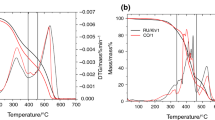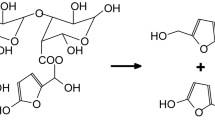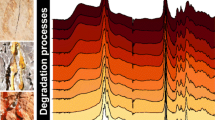Abstract
The geothermal history of natural resins from different geographical locations was studied in terms of their age assessment and structure–properties relations. Thermal properties of resin samples were analyzed by thermogravimetry (TG) and differential scanning calorimetry (DSC), whereas infrared spectroscopy was used for analysis of the resins structure. Relative dependence between thermal parameters and degree of resin maturity was found. Glass transition process and thermal events during heating of raw materials were investigated by advanced stochastic-modulated DSC method, known as TOPEM®, that allowed to determine the “true” glass transition temperature in the first heating scan. It was observed that TG method is insufficient for the resin age assessment, although it was found that there is a certain correlation between the glass transition temperature, estimated by TOPEM® DSC, and resin age. The natural resins proved to be reactive and sensitive material under elevated temperatures up to 200 °C. Subsequent processes of evaporation, relaxation and curing without significant mass loss related to degradation were observed during heating of resin samples. The aging rate in natural resins has been assessed using the intensity of 1730 cm−1 and 1646 cm−1 band after deconvolution of IR spectra. It may be assumed that younger resins are characterized by relatively higher reactivity (higher number of C=C bonds) and lower oxidation level.








Similar content being viewed by others
Change history
10 March 2020
In the original article, there were errors in the Acknowledgements section.
10 March 2020
In the original article, there were errors in the Acknowledgements section.
References
Ragazzi E, Roghi G, Giaretta A, Gianolla P (2003) Classification of amber based on thermal analysis. Thermochim Acta 404:43–54
Schmidt AR, Perrichot V, Svojtka M et al (2010) Cretaceous African life captured in amber. PNAS 107(16):7329–7334
Roghi G, Ragazzi E, Gianolla P (2006) Triassic amber of the southern Alps (Italy). Palaios 21:143–154
Ragazzi E, Schmidt AR (2011) Amber. In: Reitner J, Thiel V (eds) Encyclopedia of geobiology. Springer, Heidelberg, pp 24–36
Anderson K, Crelling JC (1996) Amber, resinite, and fossil resins, ACS symposium series. ACS, Washington
Anderson KB, Winans RE, Botto RE (1992) The nature and fate of natural resins in the geosphere—II. Identification, classification and nomenclature of resinites. Org Geochem 18(6):829–841
Anderson KB, Botto RE (1993) The nature and fate of natural resins in the geosphere—III., Org Geochem 20(7):1027–1038
Anderson KB (1994) The nature and fate of natural resins in the geosphere—IV. Middle and upper cretaceous amber from the Taimyr Peninsula, Syberia—evidence for a new form of polylabdanoid of resinite and revision of the classification of Class I resinites. Org Geochem 21(2):209–212
Wolfe AP, McKellar RC, Tappert R, Sodhi RNS, Muehlenbachs K (2016) Bitterfeld amber is not Baltic amber: three geochemical tests and further constraints on the botanical affinities of succinate. Rev Palaeobot Palynol 225:21–32
Nissenbaum A, Yaker D (1995) Stable isotope composition of amber. In: Anderson KB, Crelling JC (eds) Amber, resinite, and fossil resins. ACS, Washington, pp 32–42
Vávra N (2009) The chemistry of amber—facts, findings and opinions. Ann Naturhist Mus Wien 111(A):445–474
Zhao J, McKenna GB (2014) The apparent activation energy and dynamic fragility of ancient Ambers. Polymer 55:2246–2253
Zhao J, Ragazzi E, McKenna GB (2013) Something about amber: fictive temperature and glass transition temperature of extremely old glasses from copal to Triassic amber. Polymer 54:7041–7047
Jablonski P, Golloch A, Borchard W (1999) DSC-Measurements of amber and resin samples. Thermochim Acta 333:87–93
Anderson KB (1995) New evidence concerning the structure, composition and maturation of Class I (polylabdanoid) resinites. In: Anderson K, Crelling JC (eds) Amber, resinite and fossil resins, vol 617. American Chemical Society. Washington, DC, pp 105–129
Remm KY (1976) Late Cretaceous biting midges (Diptera, Ceratopogonidae) from fossil resins of the Khatanga Depression. Paleontol J 3:344–351
Poinar GO (1992) Life in amber. Stanford University Press, Stanford, p 368
Azar D, Adaymeh C, Jreich N (2007) Paleopsychoda zherikhini, a new Cretaceous species of moth flies from Taimyr amber (Diptera: Psychodidae: Psychodinae). Afr Invertebr 48(1):163–168
Bogdasarow MA (2010) Amber and others fossil resins of Eurasia. BrSU A.S. Pushkin, Brest, p 263
Bechtel A, Chekryzhov IY, Nechaev VP, Kononov VV (2016) Hydrocarbon composition of Russian amber from the Voznovo lignite deposit and Sakhalin Island. Int J Coal Geol. https://doi.org/10.1016/j.coal.2016.10.005
Wolfe AP, Tappert R, Muehlenbachs K, Boudreau M, McKellar RC, Basinger JF, Garrett A (2009) A new proposal concerning the botanical origin of Baltic amber. Proc R Soc Lond B Biol 276:3403–3412
Wimmer R, Rascher J, Krumbiegel G, Rappsilber I, Standke G (2009) Bitterfelder Bernstein-ein fossiles Harz und seine geologische Bedeutung. Geofokus (Geowiss.Mitt.) 38:6–15
Fuhrmann R (2008) Der Bitterfelder Bernstein—seine Herkunft und Genese. Mauritiana (Altenburg) 20:207–228
Weitschat W (2008) Bitterfelder und Baltischer Bernstein aus Paläoklimatischer und Paläontologischer Sicht. In: Rascher J, Wimmer R, Krumbiegel G, Schmiedel S (eds) Bitterfelder Bernstein versus Baltischer Bernstein: Hypothesen, Fakten, Fragen. II. Bitterfelder BernsteinkolloquiumExkursionsführer der Deutschen Gesellschaft für Geowissenschaften 236. Mecke Druck und Verlag, Duderstadt, pp 88–97
Yamamoto S, Otto A, Krumbiegel G, Simoneit BRT (2006) The natural product biomarkers in succinite, glessite and stantienite ambers from Bitterfeld, Germany. Rev Paleobot Palyno 140(1–2):27–49
Lambert JB, Levy AJ, Santiago-Blay JA, Wu Y (2013) Nuclear magnetic resonance characterization of Indonesian amber. Life Excit Biol 1:136–155
Brackman W, Spaargaren K, Van Dongen JPCM, Couperus PA, Bakker F (1984) Origin and structure of the fossil resin from an Indonesian Miocene coal. Geochim Cosmochim Ac 48:2483–2487
Adiwidjaja P, Decoster GL (1973) Pre-tertiary paleotopography and related sedimentation in South Sumatra. Indonesian Petroleum Association Sec Ann Convent Proc, pp 89–103
Kosmowska-Ceranowicz B, Sachanbiński M, Łydżba-Kopczyńska B (2017) Analytical characterization of “Indonesian amber” deposits: evidence of formation from volcanic activity. Baltica 30:55–60
Langenheim JH (2003) Plant resins. Chemistry, evolution, ecology, and ethnobotany. Cambridge, Portland, p 586
Iturralde-Vinent MA (2001) Geology of the amber-bearing deposits of the Greater Antilles. Caribb J Sci 37:141–167
DuBois MB, LaPolla JS (1999) A preliminary review of Colombian ants (Hymenoptera: Formicidae) preserved in copal. Entomol News 110:162–172
Schawe JEK, Heter T, Hertz C, Alig I, Lellinger D (2006) Stochastic temperature modulation: a new technique in temperature-modulated DSC. Thermochim Acta 446:147–155
Pagacz J, Naglik B, Stach P, Natkaniec-Nowak L, Drzewicz P (2019) Preliminary thermal characterization of natural resins from different botanical sources and geological environments. J Therm Anal Calorim. https://doi.org/10.1007/s10973-019-08157-0
Naglik B, Kosmowska-Ceranowicz B, Natkaniec-Nowak L, Drzewicz P, Dumańska-Słowik M et al (2018) Fossilization History of Fossil Resin from Jambi Province (Sumatra, Indonesia) Based on Physico-Chemical Studies. Minerals. https://doi.org/10.3390/min8030095
Winkler W, Kirchner ECh, Asenbaum A, Musso M (2001) A Raman spectroscopic approach to the maturation process of fossil resins. J Raman Spectrosc 32:59–63
Cebulak S, Matuszewska A, Langier-Kuźniarowa A (2003) Diversification of natural resins of various origin. Oxyreactive thermal analysis and infrared spectroscopy. J Thermal Anal Calorim 71:905–914
Hobel S et al (1969) Chapter 2. Heat of polymerization. J Macromol Sci Part C 3(2):339–356. https://doi.org/10.1080/15583726908545927
Montoro ÓR, Lobato Á, Baonza VG, Taravillo M (2018) Infrared spectroscopic study of the formation of fossil resin analogs with temperature using trans-communic acid as precursor. Microchem J 141:294–300
Cheng S, Friedman V, McKenna GB (2019) A calorimetry investigation of glass temperature and fragility of ancient ambers from Texas and Canada. J Non-Cryst Solid 521:119549
Kosmowska-Ceranowicz B, Wagner-Wysiecka E, Całka S (2012) Diagnostyczne pasma IRS po modyfikacji bursztynu. Pr Muz Ziemi 50:87–95
Khanjian H, Schilling M, Maish J (2013) FTIR and Py-GC/MS investigation of archaeological amber objects from the J. Paul Getty Mus e-PS 10:66–70
Shashoua Y, Lund Degn Berthelsen M-B, Nielsen OF (2006) Raman and ATR-FTIR spectroscopies applied to the conservation of archaeological Baltic amber. J Raman Spectrosc 37:1221–1227
Brody RH, Edwards HGM, Pollard AM (2001) A study of amber and copal samples using FT-Raman spectroscopy. Spectrochim Acta A 57:1325–1338
Martín-Ramos P, Fernández-Coppel IA, Ruíz-Potosme NM, Martín-Gil J (2018) Potential of ATR-FTIR spectroscopy for the classification of natural resins. BEMS Rep 4(1):3–6. https://doi.org/10.5530/bems.4.1.2
Derrick M (1989) Fourier transform infrared spectral analysis of natural resins used in furniture finishes. J Am Inst Conserv 28(1):43–56
Wagner-Wysiecka E, Szwedo J, Sontag E, Sobecka A, Czebreszuk J, Cwaliński M (eds) (2018) International symposium amber. Science and art. Gdańsk International Fair Co. (MTG SA), Gdańsk, p 127
Tumiłowicz P, Synoradzki L, Sobiecka A, Arct J, Pytkowska K, Safarzyński S (2016) Bioactivity of Baltic amber—fossil resin. Polimery. https://doi.org/10.14314/polimery.2016.347
Vávra N (2009) Amber, fossil resins, and copal—contributions to the terminology of fossil plant resins. Denisia 86:213–222
Kosmowska-Ceranowicz B, Krumbiegel G, Vávra N (1993) Glessit, ein tertiäres Harz von Angiospermen der Familie Burseraceae. Neues Jb Geol Paläontol Abh 187:299–324
McCoy VE, Boom A, Solórzano Kraemer MM, Gabbott SE (2017) The chemistry of American and African amber, copal, and resin from the genus Hymenaea. Org Geochem 113:43–54
Acknowledgements
This study was supported by the Research Grant No. 61.9012.1908.00.0 from AGH University of Science and Technology and the research Grant No. 61.9012.1908 from Polish Geological Institute-National Research Institute. Authors would also like to thank Dr. Daniel Fragiadakis, Naval Research Laboratory, USA, who develops and maintains the software Grafity (distributed free of charge at grafitylabs.com), which was used for our data analysis. Authors thanks Polymer Materials Laboratory from ŁUKASIEWICZ—Polish Center for Technology Development—for kind use of thermo-analytical equipment. Special thanks are directed to Anselm Krumbiegel for providing the resin samples that were collected by his father.
Author information
Authors and Affiliations
Contributions
JP designed the experiments, prepared figures, interpreted the data and was responsible for original draft and final version preparation. BN, LN-N, PD and PS provided samples for analysis with their geological description and were responsible for review and editing the paper.
Corresponding author
Ethics declarations
Conflict of interest
The authors declare no conflict of interest.
Additional information
Publisher's Note
Springer Nature remains neutral with regard to jurisdictional claims in published maps and institutional affiliations.
Electronic supplementary material
Below is the link to the electronic supplementary material.
10853_2019_4302_MOESM1_ESM.doc
Fig. S1. IR spectra of selected natural resins after normalization and deconvolution (spectral range of 1900–1500 cm−1 at room temperature): a RU/S/3 and DE/B/28, b PL/GD/1 with ID/SJ/7 (DOC 376 kb)
Rights and permissions
About this article
Cite this article
Pagacz, J., Naglik, B., Stach, P. et al. Maturation process of natural resins recorded in their thermal properties. J Mater Sci 55, 4504–4523 (2020). https://doi.org/10.1007/s10853-019-04302-0
Received:
Accepted:
Published:
Issue Date:
DOI: https://doi.org/10.1007/s10853-019-04302-0




